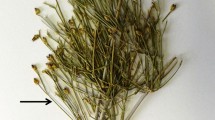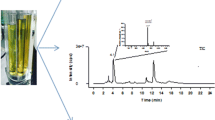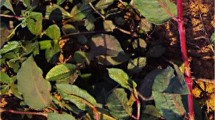Abstract
Some studies focused on metabolic relationships between plants and their endophytic bacterial associates, and more research is required to generate critical evidence for these relationships. In the current interest, we tried to confirm the relationship between the traditional medicinal plant, Calotropis procera (Aiton) W.T. Aiton, and its associated endophytes, Bacillus siamensis and Bacillus amyloliquefaciens, as the first matching study regarding the production of bioactive secondary metabolites from the plant vis-a-vis its bacterial endophytes.
Secondary metabolites of both the plant and its endophytic bacteria were extracted using different solvents, e.g., water, methanol, and ethyl acetate. All extracts exhibited high quantities of phenolics, flavonoids, tannins, and saponins. In addition, they showed significant antioxidant capacity which was found to be positively correlated with total phenolic contents. The highest total antioxidant capacity (99.28 ± 0.0 mg AA equivalent/g extract) was measured for the aqueous extract of B. siamensis.
Antibacterial activity of the different extracts was evaluated against certain pathogenic bacteria, i.e., Escherichia coli, Klebsiella pneumoniae, Streptococcus agalactiae, Salmonella typhi, Serratia marcescens, and Staphylococcus aureus. It was strikingly found that the broadest antibacterial spectrum was revealed by extracts of both C. procera and its endophytic B. siamensis. Interestingly, antibacterial activity was significantly correlated to phenolic and flavonoid contents.




Similar content being viewed by others
References
Abdel Azim NS, Shams KA, Shahat AA, El Missiry MM, Ismail SI (2011) Egyptian herbal drug industry: challenges and future prospects. Res J Med Plant 5(2):136–144
Akhtar N, Malik A, Ali SN, Kazmit SU (1992) Proceragenin, an antibacterial cardenolide from Calotropis procera. Phytochemistry 31(8):2821–2824
Aly A, Debbab A, Proksch P (2011) Fungal endophytes: unique plant inhabitants with great promises. Appl Microbiol Biotechnol 90:1829–1845
Anjum N, Chandra R (2015) Endophytic bacteria optimization of isolation procedure from various medicinal plants and their preliminary characterization. Asian J Pharm Clin Res 8(4):233–238
Babaa SA, Malikb SA (2014) Evaluation of antioxidant and antibacterial activity of methanolic extracts of Gentiana kurroo royle. Saudi J Biol Sci 21(5):493–498
Bergey DH, Holt JG (1994) Bergey’s manual of determinative bacteriology, 9th edn. Williams & Wilkins, Baltimore
Bourgaud F, Gravot A, Milesi S, Gontier E (2001) Production of plant secondary metabolites: a historical perspective. Plant Sci 161(5):839–851
Brader G, Compant S, Mitter B, Trognitz F, Sessitsch A (2014) Metabolic potential of endophytic bacteria. Curr Opin Biotechnol 27(100):30–37
Contreras-Calderón J, Calderón-Jaimes L, Guerra-Hernández E, García-Villanova B (2011) Antioxidant capacity, phenolic content and vitamin C in pulp, peel and seed from 24 exotic fruits from Colombia. Food Res Int 44(7):2047–2053
Croteau R, Kutchan TM, Lewis NG (2012) Chapter 24: Natural products (secondary metabolites). In: Civjan N (ed) Natural products in chemical biology. Wiley, Hoboken, pp 1250–1319
Cushnie TPT, Lamb AJ (2005) Antimicrobial activity of flavonoids. Int J Antimicrob Agents 26:343–356
de Melo FMP, Fiore MF, de Morales LAB et al (2009) Antifungal compound produced by the cassava endophyte Bacillus pumilus MAIIIM4A. Scientia Agricola 66(5):583–592
Deljou A, Goudarzi S (2016) Green extracellular synthesis of the silver nanoparticles using thermophilic Bacillus sp. AZ1 and its antimicrobial activity against several human pathogenetic bacteria. Iranian J Biotech 14(2):25–32
El Wahab RHA, Zaghloul MS, Kamel WM, Moustafa AA (2008) Diversity and distribution of medicinal plants in North Sinai. Egypt Afr J Environ Sci Technol 2:157–171
Firáková S, Šturdíková M, Múčková M (2007) Bioactive secondary metabolites produced by microorganisms associated with plants. Biologia Bratislava 6(23):251–257
Gouda S, Das G, Sen SK, Shin H, Patra JK (2016) Endophytes: a treasure house of bioactive compounds of medicinal importance. Front Microbiol 7:1538–1551
Gouveia S, Castilho PC (2011) Antioxidant potential of Artemisia argentea L' alcoholic extract and its relation with the phenolic composition. Food Res Int 44(6):1620–1631
Hiai S, Oura H, Nakajima T (1976) Color reaction of some sapogenins and saponins with vanillin and sulfuric acid. Planta Med 29:116–122
Julkunen-Tiitto R (1985) Phenolic constituents in the leaves of northern willows: methods for the analysis of certain phenolics. J Agric Food Chem 33:213–217
Kaaria P, Matiru V, Ndungu M (2012) Antimicrobial activities of secondary metabolites produced by endophytic bacteria from selected indigenous Kenyan plants. Afr J Microbiol Res 6:7253–7258
Kumar S, Stecher G, Li M, Knyaz C, Tamura K (2018) MEGA X: molecular evolutionary genetics analysis across computing platforms. Mol Biol Evol 35:1547–1549
Liang H, Xing Y, Chen J, Zhang D, Guo S, Wang C (2012) Antimicrobial activities of endophytic fungi isolated from Ophiopogon japonicus (Liliaceae). BMC Complement Altern Med 12:238. https://doi.org/10.1186/1472-6882-12-238
Ludwig-Müller J (2015) Plants and endophytes: equal partners in secondary metabolite production? Biotechnol Lett 37:1325–1334
Lugtenberg BJJ, Chin-A-Woeng TFC, Bloemberg GV (2002) Microbe-plant interactions: principles and mechanisms. Antonie Van Leeuwenhoek 81:373–383
McAlpine JB, Bachmann BO, Piraee M, Tremblay S, Alarco AM (2005) Microbial genomics as a guide to drug discovery, structural elucidation: ECO02301, a novel antifungal agent, as an example. J Nat Prod 68:493–496
Melliawati R, Widyaningrum DN, Djohan AC, Sukiman H (2006) Study on endophytic bacteria for bioactive compound production use as plant protection agent. Biodiver J of Biol Diver 7(3):221–224
Mittal S, Shrivastava D, Govil S, Kumar S, Bisen PS (2016) A novel anticandidal compound containing sulfur from endophytic fungus Emericella sp. Nat Prod J 6(3):188–193
Mousa WK, Raizada MN (2013) The diversity of anti-microbial secondary metabolites produced by fungal endophytes: an interdisciplinary perspective. Front Microbiol 4:65
Moustafa ARA, Sarah SQ (2017) Population ecology and economic importance of Calotropis procera as an exotic medicinal plant. J Ecol Nat Resour 1(1):000105
Orwa C, Mutua A, Kind R, Jamnadass R, Anthony S (2009) Agro forest tree Database: a tree reference and selection guide version 4.0. World Agroforestry Centre, Kenya. http://www.worldagroforestry.org/sites/treedbs/treedatabases.asp
Pongcharoen W, Rukachaisirikul V, Phongpaichit S (2008) metabolites from the endophytic fungus xylaria sp. PSU-D14. Phytochemistry 69:1900–1902
Prieto P, Pineda M, Aguilar M (1999) Spectrophotometric quantitation of antioxidant capacity through the formation of a phosphomolybdenum complex: specific application to the determination of vitamin E. Analytical Biochem 269:337–341
Reinhold-Hurek B, Hurek T (2011) Living inside plants: bacterial endophytes. Curr Opin Plant Biol 14:435–443
Rosenblueth M, Martinez-Romero E (2006a) Bacterial endophytes and their interactions with hosts. Mol Plant-Microbe Interact 19:827–837
Rosenblueth M, Martinez-Romero E (2006b) Bacterial endophytes and their interactions with hosts. Mol Plant Microbe Interact 8:827–837
Schulz B, Rommert AK, Dammann U, Aust HJ, Strack D (1999) The endophyte host interaction: a balanced antagonism? Mycol Res 103:1275–1283
Singleton VL, Orthofer R, Lamuela-Raventós RM (1999) Analysis of total phenols and other oxidation substrates and antioxidants by means of folin-ciocalteu reagent. In: Packer L (ed) Methods in enzymology: oxidants and antioxidants Part A, vol 299. Academic Press, London, pp 152–178
Stierle AA, Stierle D (2015) Bioactive secondary metabolites produced by the fungal endophytes of conifers. Nat Prod Commun 10:1671–1682
Strobel G, Daisy B, Castillo U, Harper J (2004) Natural products from endophytic, microorganisms. J Nat Prod 67:257–268
Strobel GA (2003) Endophytes as sources of bioactive products. Microbes Infect 5:535–544
Tan R, Zou WX (2001) Endophytes: a rich source of functional metabolites. Nat Prod Rep 18:448–459
Tang K, Li B, Guo SX (2014) An active endophytic fungus promoting growth and increasing salvianolic acid content of Salvia miltiorrhiza. Mycosystema 33(3):594–600
Tidke SA, Rakesh Kumar KL, Ramakrishna D, Kiran S, Kosturkova G, Gokare RA (2017) Current understanding of endophytes: their relevance, importance, and industrial potentials. J Biotechnol Biochem 3:43–59
Trapp MA, Kai M, Mitho ¨f er A, Rodrigues-Filho E (2015) Antibiotic oxylipins from Alternanthera brasiliana and its endophytic bacteria. Phytochemistry 110:72–82
Valgas C, De Souza SM, Smânia EFA (2007) Screening methods to determine antibacterial activity of natural products. Brazilian J Microbiol 38:369–380
Verghese RJ, Mathew SK, David A (2017) Antimicrobial activity of Vitamin C demonstrated on uropathogenic Escherichia coli and Klebsiella pneumoniae. J Curr Res Sci Med 3:88–93
Wani BA, Ramamoorthy D, Rather MA, Arumugam N, Qazi AK, Majeed R, Hamid A, Ganie SA, Ganai BA, Anand R, Gupta AP (2013) Induction of apoptosis in human pancreatic MiaPaCa-2 cells through the loss of mitochondrial membrane potential by Gentiana kurroo root extract and LC–ESI-MS analysis of its principal constituents. Phytomedicine 20:723–733
Wilson KH, Blitchington RB, Greene RC (1990) Amplification of bacterial 16S ribosomal DNA with polymerase chain reaction. J Clin Microbiol 28:1942–1946
Yong YH, Dai CC, Gao FK, Yang QY, Zhao M (2009) Effects of endophytic fungi on growth and two kinds of terpenoids for Euphorbia pekinensis. Chin Tradit Herb Drugs 40(7):1136–1139
Yu H, Zhang L, Li L, Zheng C, Guo L, Li W, Sun P, Qin L (2010) Recent developments and future prospects of antimicrobial metabolites produced by endophytes. Microbial Res 165:437–449
Zam SI, Agustien A, Syamsuardi Djamaan A, Mustafa I (2019) The Diversity of endophytic bacteria from the traditional medicinal plants leaves that have anti-phytopathogens activity. J trop life sci 9(1):53–63
Zhishen J, Mengcheng T, Jianming W (1999) The determination of flavonoid contents in mulberry and their scavenging effects on superoxide radicals. Food Chem 64:555–559
Acknowledgement
We introduce our sincere thanks and gratitude to the Botany Department, Faculty of Science, Aswan University for supporting and providing the requirements of scientific research.
Funding
This research did not receive any specific grant from funding agencies in the public, commercial, or not-for-profit sectors.
Author information
Authors and Affiliations
Corresponding author
Ethics declarations
Conflict of interest
We have no competing interests.
Additional information
Communicated by Erko Stackebrandt.
Publisher's Note
Springer Nature remains neutral with regard to jurisdictional claims in published maps and institutional affiliations.
Rights and permissions
About this article
Cite this article
Hagaggi, N.S.A., Mohamed, A.A.A. Plant–bacterial endophyte secondary metabolite matching: a case study. Arch Microbiol 202, 2679–2687 (2020). https://doi.org/10.1007/s00203-020-01989-7
Received:
Revised:
Accepted:
Published:
Issue Date:
DOI: https://doi.org/10.1007/s00203-020-01989-7




